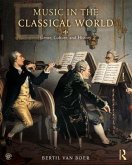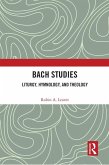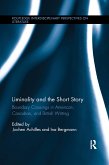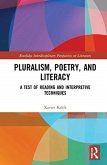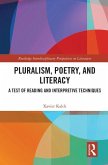- Broschiertes Buch
- Merkliste
- Auf die Merkliste
- Bewerten Bewerten
- Teilen
- Produkt teilen
- Produkterinnerung
- Produkterinnerung
Since the transformative 1960s, concert masses have incorporated a range of political and religious views that mirror their socio-cultural context. Those of the long 1960s (c1958-1975) reflect non-conformism and social activism; those of the 1980s, environmentalism; those of the 1990s, universalism; and those of the 2000s, cultural pluralism. Despite utilizing a format with its roots in the Roman Catholic liturgy, many of these politicized concert masses also reflect the increasing religious diversification of Western societies. By introducing non-Catholic and often non-Christian beliefs into…mehr
Andere Kunden interessierten sich auch für
![Music in the Classical World Music in the Classical World]() Bertil van BoerMusic in the Classical World53,99 €
Bertil van BoerMusic in the Classical World53,99 €![Political Anthropology as Method Political Anthropology as Method]() Arpad SzakolczaiPolitical Anthropology as Method38,99 €
Arpad SzakolczaiPolitical Anthropology as Method38,99 €![Bach Studies Bach Studies]() Robin A. LeaverBach Studies40,99 €
Robin A. LeaverBach Studies40,99 €![Everyday Mysteries Everyday Mysteries]() Emmy van DeurzenEveryday Mysteries41,99 €
Emmy van DeurzenEveryday Mysteries41,99 €![Liminality and the Short Story Liminality and the Short Story]() Liminality and the Short Story42,99 €
Liminality and the Short Story42,99 €![Pluralism, Poetry, and Literacy Pluralism, Poetry, and Literacy]() Xavier KalckPluralism, Poetry, and Literacy142,99 €
Xavier KalckPluralism, Poetry, and Literacy142,99 €![Pluralism, Poetry, and Literacy Pluralism, Poetry, and Literacy]() Xavier KalckPluralism, Poetry, and Literacy42,99 €
Xavier KalckPluralism, Poetry, and Literacy42,99 €-
-
-
Since the transformative 1960s, concert masses have incorporated a range of political and religious views that mirror their socio-cultural context. Those of the long 1960s (c1958-1975) reflect non-conformism and social activism; those of the 1980s, environmentalism; those of the 1990s, universalism; and those of the 2000s, cultural pluralism. Despite utilizing a format with its roots in the Roman Catholic liturgy, many of these politicized concert masses also reflect the increasing religious diversification of Western societies. By introducing non-Catholic and often non-Christian beliefs into masses that also remain respectful of Christian tradition, composers in the later twentieth century have employed the genre to promote a conciliatory way of being that promotes the value of heterogeneity and reinforces the need to protect the diversity of musics, species and spiritualities that enrich life. In combining the political with the religious, the case studies presented pose challenges for both supporters and detractors of the secularization paradigm. Overarchingly, they demonstrate that any binary division that separates life into either the religious or the secular and promotes one over the other denies the complexity of lived experience and constitutes a diminution of what it is to be human.
Produktdetails
- Produktdetails
- Verlag: Routledge / Taylor & Francis
- Seitenzahl: 256
- Erscheinungstermin: 29. Januar 2024
- Englisch
- Abmessung: 234mm x 156mm x 14mm
- Gewicht: 394g
- ISBN-13: 9781032271514
- ISBN-10: 1032271515
- Artikelnr.: 69922697
- Herstellerkennzeichnung
- Libri GmbH
- Europaallee 1
- 36244 Bad Hersfeld
- gpsr@libri.de
- Verlag: Routledge / Taylor & Francis
- Seitenzahl: 256
- Erscheinungstermin: 29. Januar 2024
- Englisch
- Abmessung: 234mm x 156mm x 14mm
- Gewicht: 394g
- ISBN-13: 9781032271514
- ISBN-10: 1032271515
- Artikelnr.: 69922697
- Herstellerkennzeichnung
- Libri GmbH
- Europaallee 1
- 36244 Bad Hersfeld
- gpsr@libri.de
Stephanie Rocke is a Research Fellow at the University of Melbourne with an ongoing interest in religious and cultural diversity as it is manifested in musical forms and musical activities across time. Recent publications reflect an expansion into the fields of music and emotion, the history of emotion, Australian music and creativity for wellbeing. The Origins and Ascendancy of the Concert Mass was published by Routledge in 2020.
Introduction
The concert mass
Concert mass background
Conceptual framework and theoretical approaches
Secularization
Issues of transcendence
Religious universalism and pluralism
Relativism
Cosmopolitan pluralists
Book structure and chapter outlines
Part I: Challenging boundaries in the long 1960s
Introduction
Civil protest
Roman Catholic Activism
Part I Case Studies - Introducing the masses of Axelrod, Davies and Bernstein
Chapter 1: David Axelrod and the Electric Prunes' psychedelic Mass in F Minor (1967)
Cultural context - the popular music industry
Mass in F Minor (1967) - The Electric Prunes & David Axelrod (1931-2017)
David Axelrod - a creative autodidact
Placing Mass in F Minor within the continuum of other masses
An absence of religion (secularization)
Psychedelic Elements of Mass in F Minor
Text
Reception
Psychedelia and the counter culture
Commodification - Mass in F minor as a product
Mass in F minor legacy
Chapter 2: Challenging Christianity: Provocative models in Peter Maxwell Davies's and Leonard Bernstein's theatrical concert masses Missa super l'homme armé (1971) and Mass (1971)
Cultural context - a thirst for change
Secularization in different spheres
Missa super l'homme armé (1969 rev. 1971) - Peter Maxwell Davies
Absurdity
Sacrifice, betrayal and Christianity
Mass (1971) - Leonard Bernstein
Faith
Social consciousness
Detractors
Part II: Expanding the concert mass into new territories
Introduction
Subversive protests
Part II case studies - Chihara and Fanshawe: similarities and differences
Chapter 3: Christianity as everyday practice: Paul Chihara's Missa Carminum: Folk Song Mass (1975)
Background and genesis
Missa Carminum: Folk Song Mass (1975)
Text juxtapositions
Melodic juxtapositions
Gloria
Eros in the music of Missa Carminum
Chapter 4: David Fanshawe's African Sanctus: A Mass for Love and Peace (1973)
Cultural and religious merging
Neo-colonial cosmopolitan patriot
Cultural and religious hybridity
Christian and Muslim perspectives
Transcultural flows
Conclusion to Part II
Part III: God meets Gaia: Concert masses for the environment
Introduction
Environmental Movement
New Spiritual Pathways
Christianity and Environmentalism
Lindisfarne Association
Part III case studies - towards natural religion: environmental concert masses of Winter, Patterson, Lentz and Larsen
Chapter 5: Paul Winter's Missa Gaia / Earth Mass (1981) and Paul Patterson's Mass of the Sea (1983)
Introduction
Paul Winter's Missa Gaia / Earth Mass (1981)
"Earth Fair"
A concert mass
Gaia & God?
Paul Patterson's Mass of the Sea
Chapter 6: David Lentz and Jessica Karraker's wolfMASS (1987) and Libby Larsen's Missa Gaia: Mass for the Earth (1992)
Introduction
wolfMASS (1987) - Daniel Lentz and Jessica Karraker
Music
Libretto
Missa Gaia: Mass for the Earth (1992) - Libby Larsen
Music for mother Earth
Libretto - replacement texts and musical choices
Credo: Speak to the Earth and It Shall Teach Thee
God?
Conclusion to Part III - Christianity as religious symbol
Part IV: Reflecting Religious Diversity
Introduction
Historical antecedents
Concert Masses
Religious plurality
Theoretical concepts
Tolerance
Moral education
David Fanshawe - African Sanctus: A Mass For Love And Peace (1973) (Reprise)
Exclusivism, inclusivism
Relativism
Concert Mass responses to plurality - universalism and pluralism
Chapter 7: Universalistic approaches: Roger Davidson's Missa Universalis I, II and III (1987-1992) and Luis Bacalov's Misa Tango (1997)
Introduction
Universalism
Roger Davidson: Missa Universalis I, II and III (1987-1992)
Nuancing Universalism
Luis Bacalov's Misa Tango (1997)
Tango and Religion
Lamb of God
Chapter 8: Towards Pluralism: Carman Moore's Mass for the 21st Century (1994-1995)
Introduction
Abandoning universalism
Inclusive pluralism
Carman Moore's Mass for the 21st Century (1994-1995)
Universalism and pluralism
Chapter 9: Pluralism in two twenty-first-century concert masses: Karl Jenkins's The Armed Man: A Mass for Peace (2000) and And on Earth Peace: A Chanticleer Mass (2007)
Introduction
The Armed Man: A Mass for Peace (2000)
Moving emotions through music
Choral and commercial success
Pluralistic aspects
And on Earth, Peace: A Chanticleer Mass (2007)
Pluralism and universlism
Spirituality
Conclusion to Part IV
Conclusion: From secularism to pluralism in forty years of politicized concert masses
Index
Concert Mass Index
The concert mass
Concert mass background
Conceptual framework and theoretical approaches
Secularization
Issues of transcendence
Religious universalism and pluralism
Relativism
Cosmopolitan pluralists
Book structure and chapter outlines
Part I: Challenging boundaries in the long 1960s
Introduction
Civil protest
Roman Catholic Activism
Part I Case Studies - Introducing the masses of Axelrod, Davies and Bernstein
Chapter 1: David Axelrod and the Electric Prunes' psychedelic Mass in F Minor (1967)
Cultural context - the popular music industry
Mass in F Minor (1967) - The Electric Prunes & David Axelrod (1931-2017)
David Axelrod - a creative autodidact
Placing Mass in F Minor within the continuum of other masses
An absence of religion (secularization)
Psychedelic Elements of Mass in F Minor
Text
Reception
Psychedelia and the counter culture
Commodification - Mass in F minor as a product
Mass in F minor legacy
Chapter 2: Challenging Christianity: Provocative models in Peter Maxwell Davies's and Leonard Bernstein's theatrical concert masses Missa super l'homme armé (1971) and Mass (1971)
Cultural context - a thirst for change
Secularization in different spheres
Missa super l'homme armé (1969 rev. 1971) - Peter Maxwell Davies
Absurdity
Sacrifice, betrayal and Christianity
Mass (1971) - Leonard Bernstein
Faith
Social consciousness
Detractors
Part II: Expanding the concert mass into new territories
Introduction
Subversive protests
Part II case studies - Chihara and Fanshawe: similarities and differences
Chapter 3: Christianity as everyday practice: Paul Chihara's Missa Carminum: Folk Song Mass (1975)
Background and genesis
Missa Carminum: Folk Song Mass (1975)
Text juxtapositions
Melodic juxtapositions
Gloria
Eros in the music of Missa Carminum
Chapter 4: David Fanshawe's African Sanctus: A Mass for Love and Peace (1973)
Cultural and religious merging
Neo-colonial cosmopolitan patriot
Cultural and religious hybridity
Christian and Muslim perspectives
Transcultural flows
Conclusion to Part II
Part III: God meets Gaia: Concert masses for the environment
Introduction
Environmental Movement
New Spiritual Pathways
Christianity and Environmentalism
Lindisfarne Association
Part III case studies - towards natural religion: environmental concert masses of Winter, Patterson, Lentz and Larsen
Chapter 5: Paul Winter's Missa Gaia / Earth Mass (1981) and Paul Patterson's Mass of the Sea (1983)
Introduction
Paul Winter's Missa Gaia / Earth Mass (1981)
"Earth Fair"
A concert mass
Gaia & God?
Paul Patterson's Mass of the Sea
Chapter 6: David Lentz and Jessica Karraker's wolfMASS (1987) and Libby Larsen's Missa Gaia: Mass for the Earth (1992)
Introduction
wolfMASS (1987) - Daniel Lentz and Jessica Karraker
Music
Libretto
Missa Gaia: Mass for the Earth (1992) - Libby Larsen
Music for mother Earth
Libretto - replacement texts and musical choices
Credo: Speak to the Earth and It Shall Teach Thee
God?
Conclusion to Part III - Christianity as religious symbol
Part IV: Reflecting Religious Diversity
Introduction
Historical antecedents
Concert Masses
Religious plurality
Theoretical concepts
Tolerance
Moral education
David Fanshawe - African Sanctus: A Mass For Love And Peace (1973) (Reprise)
Exclusivism, inclusivism
Relativism
Concert Mass responses to plurality - universalism and pluralism
Chapter 7: Universalistic approaches: Roger Davidson's Missa Universalis I, II and III (1987-1992) and Luis Bacalov's Misa Tango (1997)
Introduction
Universalism
Roger Davidson: Missa Universalis I, II and III (1987-1992)
Nuancing Universalism
Luis Bacalov's Misa Tango (1997)
Tango and Religion
Lamb of God
Chapter 8: Towards Pluralism: Carman Moore's Mass for the 21st Century (1994-1995)
Introduction
Abandoning universalism
Inclusive pluralism
Carman Moore's Mass for the 21st Century (1994-1995)
Universalism and pluralism
Chapter 9: Pluralism in two twenty-first-century concert masses: Karl Jenkins's The Armed Man: A Mass for Peace (2000) and And on Earth Peace: A Chanticleer Mass (2007)
Introduction
The Armed Man: A Mass for Peace (2000)
Moving emotions through music
Choral and commercial success
Pluralistic aspects
And on Earth, Peace: A Chanticleer Mass (2007)
Pluralism and universlism
Spirituality
Conclusion to Part IV
Conclusion: From secularism to pluralism in forty years of politicized concert masses
Index
Concert Mass Index
Introduction
The concert mass
Concert mass background
Conceptual framework and theoretical approaches
Secularization
Issues of transcendence
Religious universalism and pluralism
Relativism
Cosmopolitan pluralists
Book structure and chapter outlines
Part I: Challenging boundaries in the long 1960s
Introduction
Civil protest
Roman Catholic Activism
Part I Case Studies - Introducing the masses of Axelrod, Davies and
Bernstein
Chapter 1: David Axelrod and the Electric Prunes' psychedelic Mass in F
Minor (1967)
Cultural context - the popular music industry
Mass in F Minor (1967) - The Electric Prunes & David Axelrod (1931-2017)
David Axelrod - a creative autodidact
Placing Mass in F Minor within the continuum of other masses
An absence of religion (secularization)
Psychedelic Elements of Mass in F Minor
Text
Reception
Psychedelia and the counter culture
Commodification - Mass in F minor as a product
Mass in F minor legacy
Chapter 2: Challenging Christianity: Provocative models in Peter Maxwell
Davies's and Leonard Bernstein's theatrical concert masses Missa super
l'homme armé (1971) and Mass (1971)
Cultural context - a thirst for change
Secularization in different spheres
Missa super l'homme armé (1969 rev. 1971) - Peter Maxwell Davies
Absurdity
Sacrifice, betrayal and Christianity
Mass (1971) - Leonard Bernstein
Faith
Social consciousness
Detractors
Part II: Expanding the concert mass into new territories
Introduction
Subversive protests
Part II case studies - Chihara and Fanshawe: similarities and differences
Chapter 3: Christianity as everyday practice: Paul Chihara's Missa
Carminum: Folk Song Mass (1975)
Background and genesis
Missa Carminum: Folk Song Mass (1975)
Text juxtapositions
Melodic juxtapositions
Gloria
Eros in the music of Missa Carminum
Chapter 4: David Fanshawe's African Sanctus: A Mass for Love and Peace
(1973)
Cultural and religious merging
Neo-colonial cosmopolitan patriot
Cultural and religious hybridity
Christian and Muslim perspectives
Transcultural flows
Conclusion to Part II
Part III: God meets Gaia: Concert masses for the environment
Introduction
Environmental Movement
New Spiritual Pathways
Christianity and Environmentalism
Lindisfarne Association
Part III case studies - towards natural religion: environmental concert
masses of Winter, Patterson, Lentz and Larsen
Chapter 5: Paul Winter's Missa Gaia / Earth Mass (1981) and Paul
Patterson's Mass of the Sea (1983)
Introduction
Paul Winter's Missa Gaia / Earth Mass (1981)
"Earth Fair"
A concert mass
Gaia & God?
Paul Patterson's Mass of the Sea
Chapter 6: David Lentz and Jessica Karraker's wolfMASS (1987) and Libby
Larsen's Missa Gaia: Mass for the Earth (1992)
Introduction
wolfMASS (1987) - Daniel Lentz and Jessica Karraker
Music
Libretto
Missa Gaia: Mass for the Earth (1992) - Libby Larsen
Music for mother Earth
Libretto - replacement texts and musical choices
Credo: Speak to the Earth and It Shall Teach Thee
God?
Conclusion to Part III - Christianity as religious symbol
Part IV: Reflecting Religious Diversity
Introduction
Historical antecedents
Concert Masses
Religious plurality
Theoretical concepts
Tolerance
Moral education
David Fanshawe - African Sanctus: A Mass For Love And Peace (1973)
(Reprise)
Exclusivism, inclusivism
Relativism
Concert Mass responses to plurality - universalism and pluralism
Chapter 7: Universalistic approaches: Roger Davidson's Missa Universalis I,
II and III (1987-1992) and Luis Bacalov's Misa Tango (1997)
Introduction
Universalism
Roger Davidson: Missa Universalis I, II and III (1987-1992)
Nuancing Universalism
Luis Bacalov's Misa Tango (1997)
Tango and Religion
Lamb of God
Chapter 8: Towards Pluralism: Carman Moore's Mass for the 21st Century
(1994-1995)
Introduction
Abandoning universalism
Inclusive pluralism
Carman Moore's Mass for the 21st Century (1994-1995)
Universalism and pluralism
Chapter 9: Pluralism in two twenty-first-century concert masses: Karl
Jenkins's The Armed Man: A Mass for Peace (2000) and And on Earth Peace: A
Chanticleer Mass (2007)
Introduction
The Armed Man: A Mass for Peace (2000)
Moving emotions through music
Choral and commercial success
Pluralistic aspects
And on Earth, Peace: A Chanticleer Mass (2007)
Pluralism and universlism
Spirituality
Conclusion to Part IV
Conclusion: From secularism to pluralism in forty years of politicized
concert masses
Index
Concert Mass Index
The concert mass
Concert mass background
Conceptual framework and theoretical approaches
Secularization
Issues of transcendence
Religious universalism and pluralism
Relativism
Cosmopolitan pluralists
Book structure and chapter outlines
Part I: Challenging boundaries in the long 1960s
Introduction
Civil protest
Roman Catholic Activism
Part I Case Studies - Introducing the masses of Axelrod, Davies and
Bernstein
Chapter 1: David Axelrod and the Electric Prunes' psychedelic Mass in F
Minor (1967)
Cultural context - the popular music industry
Mass in F Minor (1967) - The Electric Prunes & David Axelrod (1931-2017)
David Axelrod - a creative autodidact
Placing Mass in F Minor within the continuum of other masses
An absence of religion (secularization)
Psychedelic Elements of Mass in F Minor
Text
Reception
Psychedelia and the counter culture
Commodification - Mass in F minor as a product
Mass in F minor legacy
Chapter 2: Challenging Christianity: Provocative models in Peter Maxwell
Davies's and Leonard Bernstein's theatrical concert masses Missa super
l'homme armé (1971) and Mass (1971)
Cultural context - a thirst for change
Secularization in different spheres
Missa super l'homme armé (1969 rev. 1971) - Peter Maxwell Davies
Absurdity
Sacrifice, betrayal and Christianity
Mass (1971) - Leonard Bernstein
Faith
Social consciousness
Detractors
Part II: Expanding the concert mass into new territories
Introduction
Subversive protests
Part II case studies - Chihara and Fanshawe: similarities and differences
Chapter 3: Christianity as everyday practice: Paul Chihara's Missa
Carminum: Folk Song Mass (1975)
Background and genesis
Missa Carminum: Folk Song Mass (1975)
Text juxtapositions
Melodic juxtapositions
Gloria
Eros in the music of Missa Carminum
Chapter 4: David Fanshawe's African Sanctus: A Mass for Love and Peace
(1973)
Cultural and religious merging
Neo-colonial cosmopolitan patriot
Cultural and religious hybridity
Christian and Muslim perspectives
Transcultural flows
Conclusion to Part II
Part III: God meets Gaia: Concert masses for the environment
Introduction
Environmental Movement
New Spiritual Pathways
Christianity and Environmentalism
Lindisfarne Association
Part III case studies - towards natural religion: environmental concert
masses of Winter, Patterson, Lentz and Larsen
Chapter 5: Paul Winter's Missa Gaia / Earth Mass (1981) and Paul
Patterson's Mass of the Sea (1983)
Introduction
Paul Winter's Missa Gaia / Earth Mass (1981)
"Earth Fair"
A concert mass
Gaia & God?
Paul Patterson's Mass of the Sea
Chapter 6: David Lentz and Jessica Karraker's wolfMASS (1987) and Libby
Larsen's Missa Gaia: Mass for the Earth (1992)
Introduction
wolfMASS (1987) - Daniel Lentz and Jessica Karraker
Music
Libretto
Missa Gaia: Mass for the Earth (1992) - Libby Larsen
Music for mother Earth
Libretto - replacement texts and musical choices
Credo: Speak to the Earth and It Shall Teach Thee
God?
Conclusion to Part III - Christianity as religious symbol
Part IV: Reflecting Religious Diversity
Introduction
Historical antecedents
Concert Masses
Religious plurality
Theoretical concepts
Tolerance
Moral education
David Fanshawe - African Sanctus: A Mass For Love And Peace (1973)
(Reprise)
Exclusivism, inclusivism
Relativism
Concert Mass responses to plurality - universalism and pluralism
Chapter 7: Universalistic approaches: Roger Davidson's Missa Universalis I,
II and III (1987-1992) and Luis Bacalov's Misa Tango (1997)
Introduction
Universalism
Roger Davidson: Missa Universalis I, II and III (1987-1992)
Nuancing Universalism
Luis Bacalov's Misa Tango (1997)
Tango and Religion
Lamb of God
Chapter 8: Towards Pluralism: Carman Moore's Mass for the 21st Century
(1994-1995)
Introduction
Abandoning universalism
Inclusive pluralism
Carman Moore's Mass for the 21st Century (1994-1995)
Universalism and pluralism
Chapter 9: Pluralism in two twenty-first-century concert masses: Karl
Jenkins's The Armed Man: A Mass for Peace (2000) and And on Earth Peace: A
Chanticleer Mass (2007)
Introduction
The Armed Man: A Mass for Peace (2000)
Moving emotions through music
Choral and commercial success
Pluralistic aspects
And on Earth, Peace: A Chanticleer Mass (2007)
Pluralism and universlism
Spirituality
Conclusion to Part IV
Conclusion: From secularism to pluralism in forty years of politicized
concert masses
Index
Concert Mass Index
Introduction
The concert mass
Concert mass background
Conceptual framework and theoretical approaches
Secularization
Issues of transcendence
Religious universalism and pluralism
Relativism
Cosmopolitan pluralists
Book structure and chapter outlines
Part I: Challenging boundaries in the long 1960s
Introduction
Civil protest
Roman Catholic Activism
Part I Case Studies - Introducing the masses of Axelrod, Davies and Bernstein
Chapter 1: David Axelrod and the Electric Prunes' psychedelic Mass in F Minor (1967)
Cultural context - the popular music industry
Mass in F Minor (1967) - The Electric Prunes & David Axelrod (1931-2017)
David Axelrod - a creative autodidact
Placing Mass in F Minor within the continuum of other masses
An absence of religion (secularization)
Psychedelic Elements of Mass in F Minor
Text
Reception
Psychedelia and the counter culture
Commodification - Mass in F minor as a product
Mass in F minor legacy
Chapter 2: Challenging Christianity: Provocative models in Peter Maxwell Davies's and Leonard Bernstein's theatrical concert masses Missa super l'homme armé (1971) and Mass (1971)
Cultural context - a thirst for change
Secularization in different spheres
Missa super l'homme armé (1969 rev. 1971) - Peter Maxwell Davies
Absurdity
Sacrifice, betrayal and Christianity
Mass (1971) - Leonard Bernstein
Faith
Social consciousness
Detractors
Part II: Expanding the concert mass into new territories
Introduction
Subversive protests
Part II case studies - Chihara and Fanshawe: similarities and differences
Chapter 3: Christianity as everyday practice: Paul Chihara's Missa Carminum: Folk Song Mass (1975)
Background and genesis
Missa Carminum: Folk Song Mass (1975)
Text juxtapositions
Melodic juxtapositions
Gloria
Eros in the music of Missa Carminum
Chapter 4: David Fanshawe's African Sanctus: A Mass for Love and Peace (1973)
Cultural and religious merging
Neo-colonial cosmopolitan patriot
Cultural and religious hybridity
Christian and Muslim perspectives
Transcultural flows
Conclusion to Part II
Part III: God meets Gaia: Concert masses for the environment
Introduction
Environmental Movement
New Spiritual Pathways
Christianity and Environmentalism
Lindisfarne Association
Part III case studies - towards natural religion: environmental concert masses of Winter, Patterson, Lentz and Larsen
Chapter 5: Paul Winter's Missa Gaia / Earth Mass (1981) and Paul Patterson's Mass of the Sea (1983)
Introduction
Paul Winter's Missa Gaia / Earth Mass (1981)
"Earth Fair"
A concert mass
Gaia & God?
Paul Patterson's Mass of the Sea
Chapter 6: David Lentz and Jessica Karraker's wolfMASS (1987) and Libby Larsen's Missa Gaia: Mass for the Earth (1992)
Introduction
wolfMASS (1987) - Daniel Lentz and Jessica Karraker
Music
Libretto
Missa Gaia: Mass for the Earth (1992) - Libby Larsen
Music for mother Earth
Libretto - replacement texts and musical choices
Credo: Speak to the Earth and It Shall Teach Thee
God?
Conclusion to Part III - Christianity as religious symbol
Part IV: Reflecting Religious Diversity
Introduction
Historical antecedents
Concert Masses
Religious plurality
Theoretical concepts
Tolerance
Moral education
David Fanshawe - African Sanctus: A Mass For Love And Peace (1973) (Reprise)
Exclusivism, inclusivism
Relativism
Concert Mass responses to plurality - universalism and pluralism
Chapter 7: Universalistic approaches: Roger Davidson's Missa Universalis I, II and III (1987-1992) and Luis Bacalov's Misa Tango (1997)
Introduction
Universalism
Roger Davidson: Missa Universalis I, II and III (1987-1992)
Nuancing Universalism
Luis Bacalov's Misa Tango (1997)
Tango and Religion
Lamb of God
Chapter 8: Towards Pluralism: Carman Moore's Mass for the 21st Century (1994-1995)
Introduction
Abandoning universalism
Inclusive pluralism
Carman Moore's Mass for the 21st Century (1994-1995)
Universalism and pluralism
Chapter 9: Pluralism in two twenty-first-century concert masses: Karl Jenkins's The Armed Man: A Mass for Peace (2000) and And on Earth Peace: A Chanticleer Mass (2007)
Introduction
The Armed Man: A Mass for Peace (2000)
Moving emotions through music
Choral and commercial success
Pluralistic aspects
And on Earth, Peace: A Chanticleer Mass (2007)
Pluralism and universlism
Spirituality
Conclusion to Part IV
Conclusion: From secularism to pluralism in forty years of politicized concert masses
Index
Concert Mass Index
The concert mass
Concert mass background
Conceptual framework and theoretical approaches
Secularization
Issues of transcendence
Religious universalism and pluralism
Relativism
Cosmopolitan pluralists
Book structure and chapter outlines
Part I: Challenging boundaries in the long 1960s
Introduction
Civil protest
Roman Catholic Activism
Part I Case Studies - Introducing the masses of Axelrod, Davies and Bernstein
Chapter 1: David Axelrod and the Electric Prunes' psychedelic Mass in F Minor (1967)
Cultural context - the popular music industry
Mass in F Minor (1967) - The Electric Prunes & David Axelrod (1931-2017)
David Axelrod - a creative autodidact
Placing Mass in F Minor within the continuum of other masses
An absence of religion (secularization)
Psychedelic Elements of Mass in F Minor
Text
Reception
Psychedelia and the counter culture
Commodification - Mass in F minor as a product
Mass in F minor legacy
Chapter 2: Challenging Christianity: Provocative models in Peter Maxwell Davies's and Leonard Bernstein's theatrical concert masses Missa super l'homme armé (1971) and Mass (1971)
Cultural context - a thirst for change
Secularization in different spheres
Missa super l'homme armé (1969 rev. 1971) - Peter Maxwell Davies
Absurdity
Sacrifice, betrayal and Christianity
Mass (1971) - Leonard Bernstein
Faith
Social consciousness
Detractors
Part II: Expanding the concert mass into new territories
Introduction
Subversive protests
Part II case studies - Chihara and Fanshawe: similarities and differences
Chapter 3: Christianity as everyday practice: Paul Chihara's Missa Carminum: Folk Song Mass (1975)
Background and genesis
Missa Carminum: Folk Song Mass (1975)
Text juxtapositions
Melodic juxtapositions
Gloria
Eros in the music of Missa Carminum
Chapter 4: David Fanshawe's African Sanctus: A Mass for Love and Peace (1973)
Cultural and religious merging
Neo-colonial cosmopolitan patriot
Cultural and religious hybridity
Christian and Muslim perspectives
Transcultural flows
Conclusion to Part II
Part III: God meets Gaia: Concert masses for the environment
Introduction
Environmental Movement
New Spiritual Pathways
Christianity and Environmentalism
Lindisfarne Association
Part III case studies - towards natural religion: environmental concert masses of Winter, Patterson, Lentz and Larsen
Chapter 5: Paul Winter's Missa Gaia / Earth Mass (1981) and Paul Patterson's Mass of the Sea (1983)
Introduction
Paul Winter's Missa Gaia / Earth Mass (1981)
"Earth Fair"
A concert mass
Gaia & God?
Paul Patterson's Mass of the Sea
Chapter 6: David Lentz and Jessica Karraker's wolfMASS (1987) and Libby Larsen's Missa Gaia: Mass for the Earth (1992)
Introduction
wolfMASS (1987) - Daniel Lentz and Jessica Karraker
Music
Libretto
Missa Gaia: Mass for the Earth (1992) - Libby Larsen
Music for mother Earth
Libretto - replacement texts and musical choices
Credo: Speak to the Earth and It Shall Teach Thee
God?
Conclusion to Part III - Christianity as religious symbol
Part IV: Reflecting Religious Diversity
Introduction
Historical antecedents
Concert Masses
Religious plurality
Theoretical concepts
Tolerance
Moral education
David Fanshawe - African Sanctus: A Mass For Love And Peace (1973) (Reprise)
Exclusivism, inclusivism
Relativism
Concert Mass responses to plurality - universalism and pluralism
Chapter 7: Universalistic approaches: Roger Davidson's Missa Universalis I, II and III (1987-1992) and Luis Bacalov's Misa Tango (1997)
Introduction
Universalism
Roger Davidson: Missa Universalis I, II and III (1987-1992)
Nuancing Universalism
Luis Bacalov's Misa Tango (1997)
Tango and Religion
Lamb of God
Chapter 8: Towards Pluralism: Carman Moore's Mass for the 21st Century (1994-1995)
Introduction
Abandoning universalism
Inclusive pluralism
Carman Moore's Mass for the 21st Century (1994-1995)
Universalism and pluralism
Chapter 9: Pluralism in two twenty-first-century concert masses: Karl Jenkins's The Armed Man: A Mass for Peace (2000) and And on Earth Peace: A Chanticleer Mass (2007)
Introduction
The Armed Man: A Mass for Peace (2000)
Moving emotions through music
Choral and commercial success
Pluralistic aspects
And on Earth, Peace: A Chanticleer Mass (2007)
Pluralism and universlism
Spirituality
Conclusion to Part IV
Conclusion: From secularism to pluralism in forty years of politicized concert masses
Index
Concert Mass Index
Introduction
The concert mass
Concert mass background
Conceptual framework and theoretical approaches
Secularization
Issues of transcendence
Religious universalism and pluralism
Relativism
Cosmopolitan pluralists
Book structure and chapter outlines
Part I: Challenging boundaries in the long 1960s
Introduction
Civil protest
Roman Catholic Activism
Part I Case Studies - Introducing the masses of Axelrod, Davies and
Bernstein
Chapter 1: David Axelrod and the Electric Prunes' psychedelic Mass in F
Minor (1967)
Cultural context - the popular music industry
Mass in F Minor (1967) - The Electric Prunes & David Axelrod (1931-2017)
David Axelrod - a creative autodidact
Placing Mass in F Minor within the continuum of other masses
An absence of religion (secularization)
Psychedelic Elements of Mass in F Minor
Text
Reception
Psychedelia and the counter culture
Commodification - Mass in F minor as a product
Mass in F minor legacy
Chapter 2: Challenging Christianity: Provocative models in Peter Maxwell
Davies's and Leonard Bernstein's theatrical concert masses Missa super
l'homme armé (1971) and Mass (1971)
Cultural context - a thirst for change
Secularization in different spheres
Missa super l'homme armé (1969 rev. 1971) - Peter Maxwell Davies
Absurdity
Sacrifice, betrayal and Christianity
Mass (1971) - Leonard Bernstein
Faith
Social consciousness
Detractors
Part II: Expanding the concert mass into new territories
Introduction
Subversive protests
Part II case studies - Chihara and Fanshawe: similarities and differences
Chapter 3: Christianity as everyday practice: Paul Chihara's Missa
Carminum: Folk Song Mass (1975)
Background and genesis
Missa Carminum: Folk Song Mass (1975)
Text juxtapositions
Melodic juxtapositions
Gloria
Eros in the music of Missa Carminum
Chapter 4: David Fanshawe's African Sanctus: A Mass for Love and Peace
(1973)
Cultural and religious merging
Neo-colonial cosmopolitan patriot
Cultural and religious hybridity
Christian and Muslim perspectives
Transcultural flows
Conclusion to Part II
Part III: God meets Gaia: Concert masses for the environment
Introduction
Environmental Movement
New Spiritual Pathways
Christianity and Environmentalism
Lindisfarne Association
Part III case studies - towards natural religion: environmental concert
masses of Winter, Patterson, Lentz and Larsen
Chapter 5: Paul Winter's Missa Gaia / Earth Mass (1981) and Paul
Patterson's Mass of the Sea (1983)
Introduction
Paul Winter's Missa Gaia / Earth Mass (1981)
"Earth Fair"
A concert mass
Gaia & God?
Paul Patterson's Mass of the Sea
Chapter 6: David Lentz and Jessica Karraker's wolfMASS (1987) and Libby
Larsen's Missa Gaia: Mass for the Earth (1992)
Introduction
wolfMASS (1987) - Daniel Lentz and Jessica Karraker
Music
Libretto
Missa Gaia: Mass for the Earth (1992) - Libby Larsen
Music for mother Earth
Libretto - replacement texts and musical choices
Credo: Speak to the Earth and It Shall Teach Thee
God?
Conclusion to Part III - Christianity as religious symbol
Part IV: Reflecting Religious Diversity
Introduction
Historical antecedents
Concert Masses
Religious plurality
Theoretical concepts
Tolerance
Moral education
David Fanshawe - African Sanctus: A Mass For Love And Peace (1973)
(Reprise)
Exclusivism, inclusivism
Relativism
Concert Mass responses to plurality - universalism and pluralism
Chapter 7: Universalistic approaches: Roger Davidson's Missa Universalis I,
II and III (1987-1992) and Luis Bacalov's Misa Tango (1997)
Introduction
Universalism
Roger Davidson: Missa Universalis I, II and III (1987-1992)
Nuancing Universalism
Luis Bacalov's Misa Tango (1997)
Tango and Religion
Lamb of God
Chapter 8: Towards Pluralism: Carman Moore's Mass for the 21st Century
(1994-1995)
Introduction
Abandoning universalism
Inclusive pluralism
Carman Moore's Mass for the 21st Century (1994-1995)
Universalism and pluralism
Chapter 9: Pluralism in two twenty-first-century concert masses: Karl
Jenkins's The Armed Man: A Mass for Peace (2000) and And on Earth Peace: A
Chanticleer Mass (2007)
Introduction
The Armed Man: A Mass for Peace (2000)
Moving emotions through music
Choral and commercial success
Pluralistic aspects
And on Earth, Peace: A Chanticleer Mass (2007)
Pluralism and universlism
Spirituality
Conclusion to Part IV
Conclusion: From secularism to pluralism in forty years of politicized
concert masses
Index
Concert Mass Index
The concert mass
Concert mass background
Conceptual framework and theoretical approaches
Secularization
Issues of transcendence
Religious universalism and pluralism
Relativism
Cosmopolitan pluralists
Book structure and chapter outlines
Part I: Challenging boundaries in the long 1960s
Introduction
Civil protest
Roman Catholic Activism
Part I Case Studies - Introducing the masses of Axelrod, Davies and
Bernstein
Chapter 1: David Axelrod and the Electric Prunes' psychedelic Mass in F
Minor (1967)
Cultural context - the popular music industry
Mass in F Minor (1967) - The Electric Prunes & David Axelrod (1931-2017)
David Axelrod - a creative autodidact
Placing Mass in F Minor within the continuum of other masses
An absence of religion (secularization)
Psychedelic Elements of Mass in F Minor
Text
Reception
Psychedelia and the counter culture
Commodification - Mass in F minor as a product
Mass in F minor legacy
Chapter 2: Challenging Christianity: Provocative models in Peter Maxwell
Davies's and Leonard Bernstein's theatrical concert masses Missa super
l'homme armé (1971) and Mass (1971)
Cultural context - a thirst for change
Secularization in different spheres
Missa super l'homme armé (1969 rev. 1971) - Peter Maxwell Davies
Absurdity
Sacrifice, betrayal and Christianity
Mass (1971) - Leonard Bernstein
Faith
Social consciousness
Detractors
Part II: Expanding the concert mass into new territories
Introduction
Subversive protests
Part II case studies - Chihara and Fanshawe: similarities and differences
Chapter 3: Christianity as everyday practice: Paul Chihara's Missa
Carminum: Folk Song Mass (1975)
Background and genesis
Missa Carminum: Folk Song Mass (1975)
Text juxtapositions
Melodic juxtapositions
Gloria
Eros in the music of Missa Carminum
Chapter 4: David Fanshawe's African Sanctus: A Mass for Love and Peace
(1973)
Cultural and religious merging
Neo-colonial cosmopolitan patriot
Cultural and religious hybridity
Christian and Muslim perspectives
Transcultural flows
Conclusion to Part II
Part III: God meets Gaia: Concert masses for the environment
Introduction
Environmental Movement
New Spiritual Pathways
Christianity and Environmentalism
Lindisfarne Association
Part III case studies - towards natural religion: environmental concert
masses of Winter, Patterson, Lentz and Larsen
Chapter 5: Paul Winter's Missa Gaia / Earth Mass (1981) and Paul
Patterson's Mass of the Sea (1983)
Introduction
Paul Winter's Missa Gaia / Earth Mass (1981)
"Earth Fair"
A concert mass
Gaia & God?
Paul Patterson's Mass of the Sea
Chapter 6: David Lentz and Jessica Karraker's wolfMASS (1987) and Libby
Larsen's Missa Gaia: Mass for the Earth (1992)
Introduction
wolfMASS (1987) - Daniel Lentz and Jessica Karraker
Music
Libretto
Missa Gaia: Mass for the Earth (1992) - Libby Larsen
Music for mother Earth
Libretto - replacement texts and musical choices
Credo: Speak to the Earth and It Shall Teach Thee
God?
Conclusion to Part III - Christianity as religious symbol
Part IV: Reflecting Religious Diversity
Introduction
Historical antecedents
Concert Masses
Religious plurality
Theoretical concepts
Tolerance
Moral education
David Fanshawe - African Sanctus: A Mass For Love And Peace (1973)
(Reprise)
Exclusivism, inclusivism
Relativism
Concert Mass responses to plurality - universalism and pluralism
Chapter 7: Universalistic approaches: Roger Davidson's Missa Universalis I,
II and III (1987-1992) and Luis Bacalov's Misa Tango (1997)
Introduction
Universalism
Roger Davidson: Missa Universalis I, II and III (1987-1992)
Nuancing Universalism
Luis Bacalov's Misa Tango (1997)
Tango and Religion
Lamb of God
Chapter 8: Towards Pluralism: Carman Moore's Mass for the 21st Century
(1994-1995)
Introduction
Abandoning universalism
Inclusive pluralism
Carman Moore's Mass for the 21st Century (1994-1995)
Universalism and pluralism
Chapter 9: Pluralism in two twenty-first-century concert masses: Karl
Jenkins's The Armed Man: A Mass for Peace (2000) and And on Earth Peace: A
Chanticleer Mass (2007)
Introduction
The Armed Man: A Mass for Peace (2000)
Moving emotions through music
Choral and commercial success
Pluralistic aspects
And on Earth, Peace: A Chanticleer Mass (2007)
Pluralism and universlism
Spirituality
Conclusion to Part IV
Conclusion: From secularism to pluralism in forty years of politicized
concert masses
Index
Concert Mass Index


